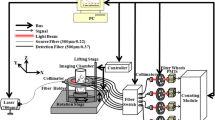ABSTRACT
Purpose
The biodistribution of Lipid/Calcium/Phosphate (LCP) nanoparticles (NPs) in tumor-bearing mice was investigated using fluorescence imaging. A quantitative validation of this method was done by 3H and 111In labeling of the nanoparticles.
Methods
The biodistribution of LCP NPs containing oligonucleotides was investigated using three different probes: Texas-Red labeled oligonucleotides, 3H-labeled oligonucleotides, and 111In-labled calcium phosphate.
Results
A discrepancy was found between the radioactivity and the fluorescence signals. Signals from 3H and 111In exhibited very similar distribution patterns, suggesting that liver and spleen were the major accumulation sites. However, fluorescence imaging indicated that tumor accumulation was predominant. We further confirmed that the fluorescence signals in both liver and spleen were greatly attenuated compared with those in the tumor due to the intrinsic tissue absorption and scattering. Near-infrared (NIR) dye Cy5.5 also suffered from the same problem, in that the quantitative data from whole organs was dramatically affected by absorption and scattering properties of the tissue.
Conclusions
Careful attention must be paid to the quantification and interpretation of fluorescence imaging measurements when comparing different tissues.




Similar content being viewed by others
REFERENCES
Juliano R. Challenges to macromolecular drug delivery. Biochem Soc Trans. 2007;35(Pt 1):41–3. Epub 2007/01/20.
Agrawal S, Temsamani J, Tang JY. Pharmacokinetics, biodistribution, and stability of oligodeoxynucleotide phosphorothioates in mice. Proc Nat Acad Sci USA. 1991;88(17):7595–9. Epub 1991/09/01.
Nakada Y, Fattal E, Foulquier M, Couvreur P. Pharmacokinetics and biodistribution of oligonucleotide adsorbed onto poly(isobutylcyanoacrylate) nanoparticles after intravenous administration in mice. Pharm Res. 1996;13(1):38–43. Epub 1996/01/01.
Beverly MB. Applications of mass spectrometry to the study of siRNA. Mass Spectrom Rev. 30(6):979–98. Epub 2010/03/05.
Chen G, Warrack BM, Goodenough AK, Wei H, Wang-Iverson DB, Tymiak AA. Characterization of protein therapeutics by mass spectrometry: recent developments and future directions. Drug discovery today. 2011;16(1-2):58–64. Epub 2010/11/26.
Frangioni JV. In vivo near-infrared fluorescence imaging. Curr Opin Chem Biol. 2003;7(5):626–34. Epub 2003/10/29.
Hilderbrand SA, Weissleder R. Near-infrared fluorescence: application to in vivo molecular imaging. Curr Opin Chem Biol.14(1):71-9. Epub 2009/11/03.
Li J, Yang Y, Huang L. Calcium phosphate nanoparticles with an asymmetric lipid bilayer coating for siRNA delivery to the tumor. J Control Release. Epub 2011/11/08.
Mackiewicz N, Gravel E, Garofalakis A, Ogier J, John J, Dupont DM, et al. Tumor-targeted polydiacetylene micelles for in vivo imaging and drug delivery. Small. 2011;7(19):2786–92. Epub 2011/08/13.
Abdelmawla S, Guo S, Zhang L, Pulukuri SM, Patankar P, Conley P, et al. Pharmacological characterization of chemically synthesized monomeric phi29 pRNA nanoparticles for systemic delivery. Mol Ther: The Journal of the American Society of Gene Therapy. 2011;19(7):1312–22. Epub 2011/04/07.
Goldberg MS, Xing D, Ren Y, Orsulic S, Bhatia SN, Sharp PA. Nanoparticle-mediated delivery of siRNA targeting Parp1 extends survival of mice bearing tumors derived from Brca1-deficient ovarian cancer cells. Proc Natl Acad Sci U S A. 2011;108(2):745–50. Epub 2010/12/29.
Yang Y, Li J, Liu F, Huang L. Systemic delivery of siRNA via LCP nanoparticle efficiently inhibits lung metastasis. Mol Ther: The Journal of the American Society of Gene Therapy. 2012;20(3):609–15. Epub 2011/12/22.
Graham MJ, Freier SM, Crooke RM, Ecker DJ, Maslova RN, Lesnik EA. Tritium labeling of antisense oligonucleotides by exchange with tritiated water. Nucleic Acids Res. 1993;21(16):3737–43. Epub 1993/08/11.
Ballou B, Ernst LA, Waggoner AS. Fluorescence imaging of tumors in vivo. Curr Med Chem. 2005;12(7):795–805. Epub 2005/04/28.
ACKNOWLEDGMENTS AND DISCLOSURES
This work was supported by NIH grants CA129835, CA129421, CA151652, CA151455 and CA149363. We thank Dr. Hong Yuan for helpful discussion and Ms. Bethany DiPrete for manuscript editing.
Author information
Authors and Affiliations
Corresponding author
Rights and permissions
About this article
Cite this article
Liu, Y., Tseng, Yc. & Huang, L. Biodistribution Studies of Nanoparticles Using Fluorescence Imaging: A Qualitative or Quantitative Method?. Pharm Res 29, 3273–3277 (2012). https://doi.org/10.1007/s11095-012-0818-1
Received:
Accepted:
Published:
Issue Date:
DOI: https://doi.org/10.1007/s11095-012-0818-1




